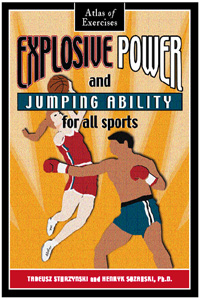by Thomas Kurz
There is much more to improving your speed than avoiding the common errors listed below, but avoiding those errors is a good start.
1. Error: Forcing it.
Trying harder does not make you faster, it makes you slower. You move fastest when you are relaxed and well-coordinated. To improve your speed you have to practice when you are relaxed and well-coordinated too, otherwise you will learn the bad habit of being excessively tensed. Excessive tension not only slows your movements but it also messes up the optimal coordination of all phases of the movement and so ruins your technique (its force and its speed).
The majority of speed exercises should be done at less than maximal speed to allow the athlete to stay relaxed and in full control of the movements (Wazny 1967), which may not be true while striving to move at the maximal speed when muscles can tense excessively.
2. Error: Toughing it out.
Do not work on speed when tired. Your concentration and coordination are off and your form becomes sloppy. You learn what you practice. You should end your speed work when either moving at your top speed or just at a high speed but very smoothly. (Not all speed exercises are to be done at top speed. More about it is in Science of Sports Training: How to Plan and Control Training for Peak Performance.)
Speed workouts are not to be all filled with exercises done at high speed. Those workouts are to improve your speed by making you reach either your top speed or move smoothly at a very high speed with perfect control in a few exercises—not through the most of the workout’s duration.
3. Error: Rushing your speed training.
First you have to have a good, smooth technique, with complete control of all its phases. If not, working on speed you will quickly hit a plateau well below your potential and you will also reinforce imperfect technique.
If you combine work on speed of movements with work on quick reaction (like in martial arts), then make sure your reaction is precise before you work on its quickness. When working on improving your reaction, initially some workouts have to be dedicated to developing its precision and not its quickness (Naglak 1979).
4. Error: Reaching for advanced methods of improving speed, such as plyometrics and weights, without really knowing what you are doing.
Extra resistance and plyometrics can be used to improve speed of movements but you really have to know what to do, how, and when. Using wrong resistance, using it at the wrong time, or in a wrong combination with other exercises will at best waste your training time. At worst it will ruin your technique or even injure you. Use of resistance for improving speed is covered in Science of Sports Training: How to Plan and Control Training for Peak Performance.
There is more to plyometrics than doing some bounding, depth jumps or medicine ball throws. You have to know how to prepare for plyometrics and how to select the right plyometric exercises. This is explained in the book Explosive Power and Jumping Ability for All Sports, which shows also progressions of plyometric exercises from the easiest to the most advanced.
5. Error: Letting days pass without work on speed—if you want to improve it.
In the periods when development of speed is a priority, speed exercises should be done as often as possible, but in small doses. In those periods up to six workouts with speed exercises may be done in a week. During the competition period, when the achieved level of speed is to be maintained, 3 or 4 workouts suffice. Two speed workouts per week is the minimal number even for beginners (Sozanski and Witczak 1981).
As soon as you have a good mastery of a given technique or just an exercise—its form and timing of its phases—work on performing it faster. Speed should be developed first in simple, then in complex movements (Harre and Hauptmann 1991). Developing the ability to move fast in any movement, even in exercises that are not sport-specific, is useful in situations when natural movements are a part of the competition activity and makes learning the sport-specific speed exercises easier.
I only wrote about the errors made in speed training. Various methods of improving speed of movements and of reaction, of overcoming plateau of speed (the speed barrier), and place of speed exercises in a workout, in a week of workouts, and in longer training periods are described in Science of Sports Training.
References are listed in Science of Sports Training (Kurz 2001). Plyometric training is extensively covered in the book Explosive Power and Jumping Ability for All Sports.
This article is based on Stadion books Science of Sports Training and Explosive Power and Jumping Ability for All Sports. Get them now and have all of the info—not just the crumbs!
If you have any questions on training you can post them at Stadion’s Sports and Martial Arts Training Discussion Forum


